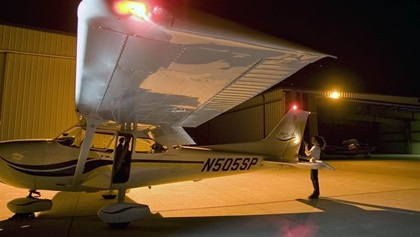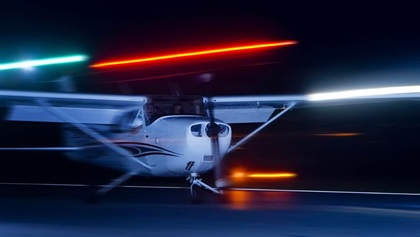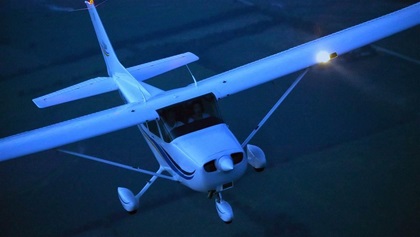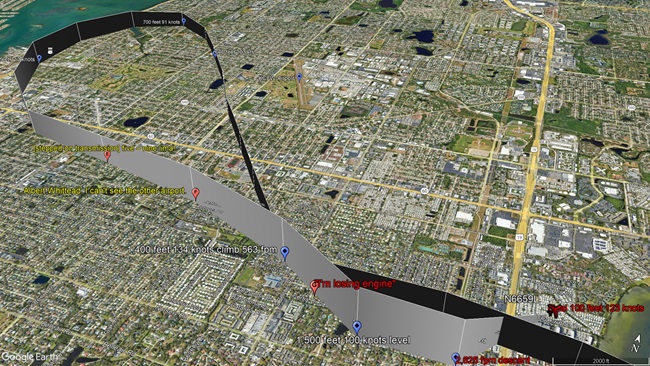It's dark out there
Prepping for your first night flight

“Once my vision adjusted to the darkness and I calmed down, I started to let myself enjoy the experience,” Berkley said. “I realized that I wasn’t lost. I was just inexperienced and didn’t fully appreciate how disorienting flying at night could be. I’d obviously flown in the area several times before, and the surrounding terrain is quite flat. There were very few obstacles that I needed to avoid, including around the airport. So, I stopped worrying and starting learning.”
As a new pilot, Berkley hadn’t realized how long it can take for your vision to adapt to changes in light conditions. Exposure to bright light can reverse the adjustment almost immediately.
“While I was outside allowing my eyes to adjust to the dark, I struck up a conversation with another student pilot. We ended up talking right under one of the parking lot lights. I didn’t think anything of it at the time and didn’t think my vision was affected, even after we were in the air. I just thought it was a really dark night,” he said.
“But as the minutes passed during and after my initial panic, my vision became much better, and I realized that my vision hadn’t adjusted properly by the time we were ready for takeoff. I was embarrassed so I didn’t tell my instructor at first. But eventually I did, and he flew the airplane as we both waited for my vision to re-adjust before giving me back the controls.”
For most phases of flight, the only difference between flying at night compared to flying in the day is that it’s darker, said Steve Davis, a flight instructor at Aero America Flight Training in Des Moines, Iowa. “The airplane flies exactly the same,” he said.
However, the darkness and inability to recognize landmarks may cause pilots fear and discomfort, as they did with Berkley during his first night flight. Night flying warrants some practices similar to those used by instrument-rated pilots flying in low visibility under instrument flight rules (IFR).
“It’s important to understand that a night takeoff is nearly an IFR procedure,” Davis said. “Plan your initial climb to avoid obstacles you would more easily see during the day and give yourself plenty of altitude. Clouds below you can be nearly invisible on a dark night, so make sure you have good VFR conditions for flight. You should also plan your route with runways and freeways that will be available for an emergency landing.”
Being prepared helps minimize risk and minimize fear before panic has a chance to take over. Plan your flight on the conservative side. Fly near roads and airports. Fly higher to avoid obstacles than you would during the day and have an emergency action plan. And don’t overlook the small things—such as batteries. “Take two sources of light with you and always keep extra batteries on hand. You should also bring your cellphone with you. Of course, make sure it’s charged first,” Davis said.
 Getting to know your destination, and local and en route airports, is another important step in preparation for flight. This is vital during the day but even more crucial at night, when there are fewer options in case of an emergency. Davis advised pilots to review the chart supplement and information in your flight planning software. “Read the comments in the software about the destination airport, and check the FBO’s operating hours and have access to their after-hour numbers. When planning your route, check to make sure fuel is available at your destination and plan to have plenty of fuel when you arrive.”
Getting to know your destination, and local and en route airports, is another important step in preparation for flight. This is vital during the day but even more crucial at night, when there are fewer options in case of an emergency. Davis advised pilots to review the chart supplement and information in your flight planning software. “Read the comments in the software about the destination airport, and check the FBO’s operating hours and have access to their after-hour numbers. When planning your route, check to make sure fuel is available at your destination and plan to have plenty of fuel when you arrive.”
Berkley added that his frightening experience made him a better pilot. “I learned just how important preflight planning was that night. I planned the entire flight properly, but I didn’t check the little things I took for granted during the day—like being able to see trees and other obstacles that stood out in the light but were nearly invisible at night.”
“Night is one of the most delightful times to fly. Everything seems to calm down. The air mass, the controllers, and the traffic. It’s a gorgeous time to be out, on most nights.” —Zoan Harclerode, AOPA Flight Training Experience Award National Best Flight Instructor for 2017“I didn’t realize it in the moment, but my poor vision combined with my inexperience is what caused me to panic in the first place,” Berkley said. “Yes, it was a dark night, but it wasn’t that dark. It became a lot lighter once my vision had adjusted and I was even able to identify familiar landmarks that were invisible when my eyes weren’t night ready. I wasn’t afraid of being lost anymore. Feeling familiar with the area again made me feel safe, relaxed, and able to fly the airplane like I did during the day,” he said.
Give yourself at least 30 minutes for your eyes to adjust to the dark before taking off. Davis recommended pointing at switches in the cockpit to improve your skills while your eyes adjust before taking off. As Berkley found out, it’s important not to expose your eyes to any bright white light—it can ruin your adapted vision in seconds. Using a flashlight with a red lens can help prevent exposing your eyes to light that can harm your vision. The rods in your eyes are not sensitive to red light, so it won’t cause your eyes to re-adjust. However, the red light will make any red marks that you’ve made on a sectional chart become invisible, so make sure your marks are written in black so they’ll show up clearly.
Altitude can also degrade your night vision because of the decreased supply of oxygen available. Your eyes are oxygen-hungry organs, and a lack of oxygen can make night vision nearly impossible. This is one of the reasons smoking before a flight is a bad idea. Some experts recommend the use of supplemental oxygen in the cockpit for night flights above 5,000 feet.
When few lights or terrain features are visible around an airport—especially an unfamiliar one—a student might feel as though he’s flying into a black hole. Bright runway lights and unfamiliar terrain might also cause students to believe they are closer to the runway than they actually are. Davis said, “Don’t land at an unfamiliar airport at night without VASI lights and don’t fly below the VASI.” This is another reason why it’s so important to become familiar with each airport along your route and at your destination.
Flying at night presents more challenges than flying during the day, but the rewards are great: Winds tend to die down, the views are beautiful, and fewer people flying means less chatter on the radio so you can enjoy the serenity of the evening. Prepare yourself for the additional risk factors of night flight, and always have a plan of action in case of an emergency. Familiarize yourself with your surroundings. Give yourself plenty of time for your flight. And most of all, enjoy it.
Scott Hotaling is a freelance writer living in New York.
 Laser strikes
Laser strikes


